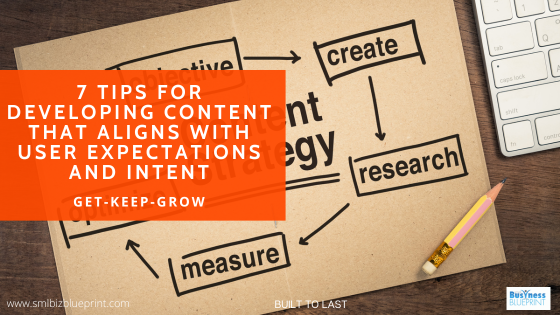Creating content that aligns with user expectations and intent is crucial for achieving marketing success in today’s digital landscape.
Why?
Delivering the right message at the right time directly influences user engagement, search engine rankings, and conversion rates.
This blog post will explore actionable techniques to enhance your content strategy.
We’ll uncover ways to identify your target audience’s intent, optimise your SEO strategy for success, and incorporate long-tail keywords for reaching niche audiences.
You’ll also learn how to create engaging content by incorporating user feedback, updating existing content to keep it relevant, and evaluating your content using key metrics.
Plus, we’ll reveal the tools you can leverage to analyse user intent and fine-tune your strategy.
By the end of this post, you’ll have the knowledge and tools to develop content that resonates with your audience and drives consistent results.

#1 Identify Your Target Audience’s Intent
Understanding your audience’s intent is the cornerstone of crafting content that resonates deeply with them. When you know what your readers seek, you can address their needs directly, leading to improved engagement and conversions.
Here’s how you can identify your target audience’s intent:
Segment Your Audience
Begin by segmenting your audience into distinct groups based on demographics, behaviour, and psychographics. This segmentation will enable you to create highly targeted content for each group.
For instance, new visitors to your blog will require more introductory information, while returning visitors may be looking for advanced insights.
Analyse Search Queries
Utilise Google Analytics or your preferred web analytics platform to analyse search queries leading users to your site. This data reveals common questions and interests. If “content marketing for beginners” is a frequent search term, your audience likely includes people new to the field.
Create comprehensive guides or explainer posts targeting their needs.
Survey Your Audience
Direct feedback is invaluable. Run surveys via email or on your website, or engage with your audience on social media. Ask them what challenges they face or what content they want to see.
Surveys can reveal niche topics that are not obvious from search data.
Observe Behavior on Your Site
Identify which pages and blog posts have high engagement rates. Look for patterns in bounce rates and time on the page to determine which types of content best align with user expectations.
Create User Personas
Develop detailed user personas representing your audience’s interests, pain points, and goals based on the data collected. Tailor content strategies to these personas to ensure a consistent message that addresses their intent.
By incorporating these practices into your strategy, you’ll clearly understand your audience’s needs and expectations.
Aligning your content with this intent will help you deliver value at every touchpoint, solidifying trust and loyalty with your readers.
#2 Optimize Your Content Strategy for SEO Success
Balancing SEO optimisation with content quality is crucial to align with user expectations effectively. When your blog post ranks high on search engine results pages (SERPs) while delivering relevant and valuable information, your audience finds the answers they’re seeking, and your website gains credibility.
Here’s how to optimise your content strategy for SEO success:
Conduct Keyword Research
Start with thorough keyword research to identify high-value terms relevant to your niche. Use tools like Google Keyword Planner, Ahrefs, or SEMrush to find terms with significant search volumes and reasonable competition.
Focus on primary keywords that define your content’s core topic and secondary keywords that support various aspects of your subheadings.
Use Keywords Naturally
Avoid keyword stuffing, which can harm readability and lead to search engine penalties. Instead, incorporate primary and secondary keywords naturally throughout your content.
Place your primary keyword in the title, meta description, and first 100 words of your post. Secondary keywords should complement subheadings and appear where relevant.
Optimise Meta Tags
Write compelling meta titles and descriptions that include primary keywords while summarising the blog post’s value. The meta description should be within 150-160 characters and encourage readers to click through.
Utilise Internal and External Links
Link internally to related posts on your blog to keep users engaged and reduce bounce rates. External links to authoritative sources can also boost credibility and give readers a richer understanding of the topic.
Structure Your Content
Break up text with concise paragraphs, bullet points, and subheadings. This makes your content more digestible, allowing readers to find what they want quickly. Google prioritises user experience, so formatting is essential.
Optimise for Mobile and Speed
Ensure your blog is mobile-friendly and loads quickly. Google has shifted to mobile-first indexing, meaning mobile usability is now a significant ranking factor. Compress images, minimise code, and reduce redirects to speed up load times.
Following these SEO optimisation strategies while keeping the user’s intent in focus will ensure your content ranks well and meets readers’ needs.
This approach will improve visibility and provide long-term value by fostering a positive user experience.
#3 Incorporate Long-Tail Keywords for Niche Audience Reach
Long-tail keywords are essential for reaching niche audiences and driving conversions because they address particular search queries. Although their search volumes are lower, they collectively account for significant web traffic.
Here’s how you can incorporate long-tail keywords to boost your content strategy:
Understand the Value of Long-Tail Keywords
Long-tail keywords, often three to five words long, capture users’ intent further in the decision-making process.
For instance, “How to improve Facebook ad performance” or “Best running shoes for flat feet” target niche queries that will likely result in higher engagement and conversions.
Conduct Long-Tail Keyword Research
Utilise tools like Google Keyword Planner, SEMrush, or Ahrefs to identify long-tail keywords that align with your content theme. Pay attention to queries that convey informational, navigational, or transactional intent and find ways to address them comprehensively.
Use Long-Tail Keywords in Subheadings
Subheadings are the perfect place to incorporate long-tail keywords, as they help break down specific aspects of your topic while improving the content’s scannability.
For instance, a post on “content marketing strategy” can have subheadings like “how to create a content calendar” or “tools for analysing user intent.”
Write In-Depth Content
When focusing on long-tail keywords, ensure your content thoroughly addresses the topic. Users searching with long-tail queries expect comprehensive answers.
This means covering each query point-by-point, providing examples, and offering further resources to keep users engaged.
Use Natural Language
Long-tail keywords often reflect how people speak or ask questions. Incorporate them naturally within the text and answer their implied questions directly. This also aligns with Google’s evolving focus on conversational searches.
Monitor and Adjust
Using web analytics tools, track the long-tail keywords driving traffic and conversions to your content. Based on trends and changing audience behaviours, adjust and refine your keyword strategy.
Incorporating long-tail keywords into your blog post ensures you’re addressing the specific needs of your audience, ultimately leading to more targeted traffic and higher engagement.
By combining them with solid SEO practices, you’ll see improved search rankings and conversion results.

#4 Create Engaging Content with User Feedback
User feedback is a goldmine of insights that can guide your content strategy and ensure it aligns with your audience’s expectations. By actively listening to and incorporating this feedback, you can build a stronger connection with your readers and keep your content relevant.
Here’s how to use user feedback effectively:
Understand the Importance of Feedback
Listening to your audience’s direct feedback provides practical insights into their needs and challenges. It also fosters a sense of community and demonstrates that their voices are valued.
Gather Feedback Through Multiple Channels
Use surveys, polls, and social media platforms to solicit feedback directly. You can also leverage website analytics to understand user behaviour, such as pages with high exit rates, which may indicate a mismatch between content and expectations.
Analyse and Identify Common Themes
Group feedback by common themes to identify recurring pain points, questions, or topics that require clarification. If multiple users are confused about a specific topic, create comprehensive content that addresses it.
Incorporate Feedback into Your Content
Update Existing Content: Refresh older posts to address user concerns or add more value by incorporating updated information, relevant examples, or new data.
Create New Content: When users frequently ask questions or express challenges about a particular area, develop new posts around these themes, ensuring they’re optimised with relevant keywords.
Provide FAQs: Include an FAQ section in your blog posts to answer frequently asked questions that emerge through feedback channels. This can help readers find answers quickly.
Encourage Feedback in Your Content
Prompt readers to leave comments or share their experiences at the end of your blog posts. You can also ask them to participate in polls or surveys to gather deeper insights.
Foster Community Engagement
Engage with your readers directly in the comment sections, social media posts, or via email. Responding to comments shows readers you value their input, building trust and encouraging them to return.
You can create posts that resonate deeply with your audience by weaving user feedback into your content strategy.
This engagement not only improves the relevance of your content but also boosts search engine rankings by increasing time on the page and reducing bounce rates.
#5 Update Existing Content to Stay Relevant
Updating your older content effectively maximises its potential by keeping it relevant and valuable for your audience. Search engines also value freshness, often rewarding up-to-date content with higher rankings.
Here’s how to rejuvenate your existing posts:
Identify High-Potential Posts
Use analytics tools to find older posts that still attract significant traffic but may need to be updated in information or structure. Focus first on these posts to boost your overall content effectiveness.
Add New Information and Resources
Incorporate the latest statistics, trends, and insights into your older posts to ensure they remain accurate and helpful. Update any outdated examples and add new links to recent authoritative sources for further reading.
Incorporate New Keywords
Research new long-tail keywords and phrases trending in your industry and incorporate them naturally into older posts. This expands your reach to users searching for newer terms and provides more specificity for niche queries.
Improve Readability and Formatting
Break up lengthy paragraphs into shorter chunks, and add bullet points, subheadings, or graphics to improve scannability. This will help retain users’ attention and make the post easier to digest.
Add an FAQ Section
Create an FAQ section based on user questions in comments or other channels. This will help address evolving audience needs and improve the post’s completeness.
Update Internal and External Links
Review all links to ensure they’re still accurate and relevant. Link to newer internal posts to encourage readers to explore other content and replace broken or outdated external links with authoritative sources.
Re-Promote Updated Content
Once you’ve refreshed the post, re-promote it on social media, via email newsletters, and through internal linking on your website. Tell your audience about the updates to attract new readers and re-engage past visitors.
Refreshing existing content ensures it remains aligned with user expectations and industry trends. This approach can significantly increase organic traffic, improve engagement metrics, and make your blog a valuable resource for your audience.
#6 Evaluate Your Content Using Key Metrics
Assessing the success of your content through data-driven analysis is vital to understanding what resonates with your audience and what needs improvement.
Here are some essential metrics and strategies to consider when evaluating your content:
Traffic and Page Views
Track your blog posts’ total traffic and page views using web analytics tools like Google Analytics. These metrics indicate the overall reach of your content and highlight posts that attract substantial attention.
Average Time on Page
This metric measures how long visitors stay on a specific page. Higher times suggest your content is engaging and valuable, while shorter times indicate a need for more engaging copy, better formatting, or more apparent intent.
Bounce Rate
A high bounce rate means visitors leave after viewing only one page. This could be due to content that doesn’t match user expectations or an overly broad keyword focus. To reduce the bounce rate, refine your topic focus, add internal links, and ensure a clear structure.
Scroll Depth
Scroll depth reveals how far readers progress through your posts, indicating whether they consume your entire article or leave midway. Analyse this to improve your article structure and maintain user engagement throughout.
Conversions and Goals
Define clear goals for each piece of content, such as newsletter sign-ups, downloads, or product purchases. Use conversion tracking in analytics tools to see how well your content drives these goals.
Social Engagement
Monitor how often your posts are shared, liked, or commented on through social media platforms. High social engagement indicates that your content resonates well with readers.
Comments and Feedback
Reader comments can offer valuable insights into how well your content aligns with expectations. Encourage comments, promptly address questions, and look for patterns to guide future content improvements.
Refine Your Strategy
Regularly evaluate your metrics to identify content strengths and weaknesses. Based on these insights, refine your content strategy to deliver posts that continuously meet and exceed user expectations.
By carefully tracking and analysing these metrics, you’ll be able to identify which content is compelling and why. This data will empower you to optimise future posts, address gaps in your strategy, and ultimately create content that aligns better with your audience’s needs.

#7 Leverage Tools to Analyze User Intent
Analytical tools are crucial for decoding user intent and fine-tuning your content strategy. These tools reveal what your audience is searching for, how they interact with your content, and where opportunities for improvement lie.
Here’s how to harness these tools for more profound insights:
Google Analytics
This comprehensive tool provides critical insights into user behaviour, such as which pages attract the most traffic, visitors’ geographic location, and the keywords used to find your site. You can also analyse bounce rates and average session duration to gauge engagement.
Google Search Console
Google Search Console helps you monitor your website’s presence on search engine results pages (SERPs). It shows which queries bring users to your site and which pages have high or low click-through rates. Use this data to refine content around the queries with high potential.
Keyword Research Tools
Tools like Ahrefs, SEMrush, or Moz provide detailed keyword data, revealing search volumes, competition, and related search queries. Use this information to identify new long-tail keywords and expand your content to address different facets of user intent.
Heatmaps and Session Recordings
Tools like Hotjar or Crazy Egg visually represent user interactions, showing where visitors click, scroll, or linger on a page. By identifying these patterns, you can improve content layout and optimise high-engagement areas.
Surveys and Feedback Forms
Integrate surveys and feedback forms into your site to gather direct insights from your audience about their needs and preferences. Tools like SurveyMonkey or Typeform make it easy to create customised questions.
Social Media Analytics
Social media platforms like Facebook, Twitter, and LinkedIn offer built-in analytics showing which posts are shared, liked, or commented on the most. Use these metrics to identify trending topics or interests that can inform your content strategy.
A/B Testing Tools
Experiment with different content formats, headlines, or layouts using A/B testing tools like Optimizely. By testing variations and comparing results, you can optimise future content for higher conversions and engagement.
These tools provide the data needed to understand user intent more comprehensively. This understanding will help you refine your content strategy to align closely with your audience’s expectations, creating a cycle of continuous improvement and relevance.
Conclusion
In today’s competitive digital landscape, aligning your content with user expectations and intent is vital for driving meaningful engagement and long-term success. You can deliver targeted and valuable information by understanding your audience’s needs, optimising your content for SEO success, and incorporating user feedback and long-tail keywords.
Regularly updating older posts and evaluating your strategy through key metrics ensures your content stays relevant and practical. Leveraging analytical tools to decode user intent will further enhance your plan, making your blog a go-to resource for your audience.
Now, it’s time to take action. Begin by identifying your target audience’s intent, and refine your content strategy using the strategies shared here.
Start implementing these tips today if you’re ready to transform your blog into a highly engaging and valuable resource. Watch as your content resonates deeply, ranks higher, and drives consistent results.
FAQs
Q1. How do I determine my target audience’s intent?
A1: Use web analytics tools to analyse search queries leading visitors to your site. Conduct surveys and polls, engage with your audience on social media, and review page behaviour metrics like bounce rates to gain deeper insights into their interests.
Q2. What are the most effective ways to optimise content for SEO?
A2: Conduct thorough keyword research and incorporate keywords naturally in your titles, meta descriptions, and content. Break up text with subheadings and bullet points, and improve load times to ensure your site is mobile-friendly.
Q3. Why should I focus on long-tail keywords?
A3: Long-tail keywords address specific queries and often reflect how people speak. They capture niche audiences further in the decision-making process, leading to higher engagement and conversion rates.
Q4. How often should I update my existing blog posts?
A4: Aim to review and update existing posts every 6-12 months, depending on the topic. Posts with consistent traffic may need more frequent updates, especially if new data, trends, or examples are available.
Q5. Which key metrics should I track to measure my content’s effectiveness?
A5: Important metrics include traffic, average time on page, bounce rate, scroll depth, conversions, social engagement, and comments. These metrics will help you understand your content’s performance and where improvements are needed.
Q6. How can user feedback improve my content strategy?
A6: Direct feedback from surveys, social media, and comments can help you identify recurring questions, pain points, or interests. By addressing these topics in your content, you can better align with audience expectations and build trust.
Q7. What tools can help me analyse user intent?
A7: Google Analytics and Search Console provide insights into user behaviour and queries. Heatmap tools like Hotjar, keyword research platforms like Ahrefs, and A/B testing tools like Optimizely offer additional data to refine your content strategy.
Other Articles
How Micro-conversions Help Small Businesses Refine Marketing Strategies
Empower Your Business: 10 Data-Driven Actions For Small Business
The Ultimate Guide to Implementing a Kanban System in Your Small Business




